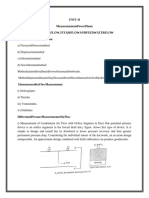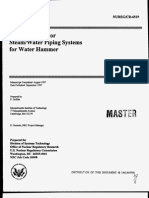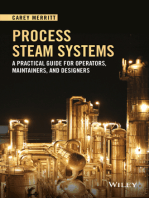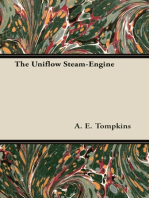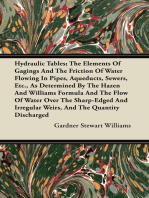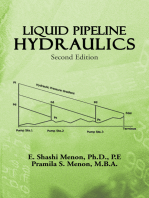Residence Time
Residence Time
Uploaded by
tetemian8778Copyright:
Available Formats
Residence Time
Residence Time
Uploaded by
tetemian8778Original Description:
Copyright
Available Formats
Share this document
Did you find this document useful?
Is this content inappropriate?
Copyright:
Available Formats
Residence Time
Residence Time
Uploaded by
tetemian8778Copyright:
Available Formats
FIG.
19-36
Bottom Vapor Inlet
FIG. 19-37
22
Residence Time for Liquid in the Sump21
nozzles and other internal considerations must be addressed
to eliminate problems. Kister21 presented a series of articles
which discussed these areas in detail.
Tray sections and baffles that are contacted by an entering
feed should be strengthened and feed nozzles should be anchored to the tower shell. Feed lines containing two phase flow
should be designed to minimize slugging which causes column
instability and possible tray damage. For liquid feeds, the nozzle velocity should not exceed 0.9 m/s.
Minimum
residence
time, min
Liquid is withdrawn by level control and
feeds another column directly by pressure
Liquid is withdrawn by level control and
pumped away. Spare pump starts manually.
Liquid is withdrawn by level control and
pumped away. Spare pump starts automatically.
Liquid is withdrawn by level control anf
feeds a unit that is some distance away
or that has its instruments on a different control board.
5-7
Liquid is withdrawn by flow control.
3-5
Liquid flows through a thermosyphon reboiler without a level controller, to maintain a level in the sump.
Top Feed Nozzles Fig. 19-32 illustrates various arrangements used for top-tray feed and reflux nozzles. Fig.
19-33 lists factors and restrictions in each design. For cost
reasons, arrangements of Fig. 19-32a, b, c, e, and f are preferred. However, for a two-phase stream only b, d, e, and h are
suitable. Most installations use arrangement a or c for all-liquid feed while b and e are popular for a two-phase feed.
Operating condition
Intermediate Feed Nozzles Fig. 19-34 shows various methods for introducing intermediate column feeds.
Fig. 19-35 summarizes the application area for each design.
Fig. 19-34a is only suitable for subcooled liquids. Vapor containing or hot feeds would cause flashing in the downcomer
and loss of capacity. Fig. 19-34b is only suitable for low-velocity liquid feeds and is seldom recommended. Fig. 19-34c and
d show a similar nozzle location with a baffle to direct the feed
stream. These are both designed for two-phase streams with
d being the preferred arrangement. Fig. 19-34c can be used for
FIG. 19-38
Example Baffle Arrangements for Bottom Sumps for Recirculating Reboilers21
Reboiler
Return
Reboiler
Return
Reboiler
Return
Auxiliary
Baffle
Reboiler
Return
Preferential
Baffle
To
Reboiler
Bottom
Product
a.
To
Reboiler
Bottom
Product
To
Reboiler
b.
Bottom
Product
c.
19-25
To
Reboiler
Bottom
Product
d.
You might also like
- 4TH Class Part B Review QuestionsDocument14 pages4TH Class Part B Review QuestionsCalvin Jude Goveia100% (1)
- USCG ME Exam - General KnowledgeDocument262 pagesUSCG ME Exam - General KnowledgelazyreaderrNo ratings yet
- Mech DesignDocument4 pagesMech DesignBạch Trung PhúNo ratings yet
- Flooded CondensersDocument13 pagesFlooded Condensersstreamt100% (1)
- BOPs and Their ControlDocument59 pagesBOPs and Their ControlYoun Seok Choi100% (1)
- BOPs and Their ControlDocument59 pagesBOPs and Their Controlelflaco79No ratings yet
- Tutorial - Cold Water SupplyDocument7 pagesTutorial - Cold Water SupplyyugerajdNo ratings yet
- Reboiler HydraulicDocument3 pagesReboiler Hydraulic54yreyeNo ratings yet
- 1 s2.0 S0255270107002231 MainDocument10 pages1 s2.0 S0255270107002231 MainJuanIgnacio1No ratings yet
- Jet 4Document4 pagesJet 4prazNo ratings yet
- BFP & AuxiliriesDocument70 pagesBFP & AuxiliriesVivek Painkra100% (1)
- Piping Eveporative COndensersDocument12 pagesPiping Eveporative COndensersscribd99190No ratings yet
- The Condensate, The Boiler Feed, and Their Auxiliary SystemsDocument70 pagesThe Condensate, The Boiler Feed, and Their Auxiliary Systemsbabis1980100% (1)
- Document PDFDocument4 pagesDocument PDFck19654840No ratings yet
- 131A Piping BrochureDocument12 pages131A Piping Brochuredeanewing11No ratings yet
- Power Plant 2Document6 pagesPower Plant 2720721107017No ratings yet
- Energy Impacts of Chiller Water Piping ArrangementDocument8 pagesEnergy Impacts of Chiller Water Piping ArrangementYaz100% (1)
- Refrigerant Piping: By: Cecil R. Visger, Past International PipingDocument18 pagesRefrigerant Piping: By: Cecil R. Visger, Past International PipingBehnam AshouriNo ratings yet
- Layout Arrangement For Centrifugal Pump PipingDocument20 pagesLayout Arrangement For Centrifugal Pump PipingKyaw Kyaw Aung50% (2)
- A Study On The Types of Reboilers: Ruben ChatterjeeDocument12 pagesA Study On The Types of Reboilers: Ruben ChatterjeeAnonymous ka2kX4jNNo ratings yet
- Slug Catcher SizingDocument8 pagesSlug Catcher Sizingporchfroggy100% (1)
- Layout Arrangement For Centrifugal Pump PipingDocument30 pagesLayout Arrangement For Centrifugal Pump PipingAlderit BarajasNo ratings yet
- U-9 Shutdown DefectsDocument5 pagesU-9 Shutdown Defectssarojdubey0107No ratings yet
- High Rise Water Supply SystemDocument4 pagesHigh Rise Water Supply SystemSonia Dogra50% (2)
- Diesel Engineering HandbookDocument14 pagesDiesel Engineering Handbookmartin.ruben100% (1)
- Pages From HVAC Design Handbook (301 450)Document150 pagesPages From HVAC Design Handbook (301 450)zaffar731No ratings yet
- Mep UscgDocument120 pagesMep UscgAdwaith KrishnanNo ratings yet
- Centrifugal Pump Piping Design LayoutDocument21 pagesCentrifugal Pump Piping Design LayoutKavin KumarNo ratings yet
- Reboiler and VaporiserDocument56 pagesReboiler and Vaporiserjihad jamareiNo ratings yet
- Teh-775a-1 230810 133451Document67 pagesTeh-775a-1 230810 133451Kyriakos MichalakiNo ratings yet
- Process Plant ServicesDocument11 pagesProcess Plant ServicesByme GsckcNo ratings yet
- The Condenser and Its Auxiliary SystemsDocument47 pagesThe Condenser and Its Auxiliary Systemsihllhm100% (1)
- 1 GeneralDocument548 pages1 Generalclinthen100% (1)
- Screening Reactor For Water HammerDocument49 pagesScreening Reactor For Water HammerYu GanNo ratings yet
- WDAAA116787 - B - 25 Steam SystemDocument14 pagesWDAAA116787 - B - 25 Steam SystemRenee Boy GunitaNo ratings yet
- Module 2Document4 pagesModule 2ShahrizatSmailKassimNo ratings yet
- 17-Oil Centrifuge PDFDocument89 pages17-Oil Centrifuge PDFUmangtarangNo ratings yet
- Centrifugal Pump PipingDocument22 pagesCentrifugal Pump PipingBhupender Sharma100% (4)
- Constanta Tivig V2no4 FullDocument5 pagesConstanta Tivig V2no4 FullCatalin SamoilNo ratings yet
- Plant Layout-CompressorsDocument19 pagesPlant Layout-Compressorshalder_kalyan9216No ratings yet
- 2.0 Process Liquid Lines PrefaceDocument23 pages2.0 Process Liquid Lines PrefaceCristhianNo ratings yet
- tentativeBoilerCleanUp 230509 112910Document2 pagestentativeBoilerCleanUp 230509 112910sarojdubey0107No ratings yet
- Hydraulic & PnumaticDocument9 pagesHydraulic & PnumaticDeepak Kumar100% (1)
- Part 12. Water and DX System - Chapter 1. Fan-Coil Unit SystemDocument1 pagePart 12. Water and DX System - Chapter 1. Fan-Coil Unit SystemKarthikeyan SankarrajanNo ratings yet
- Process Steam Systems: A Practical Guide for Operators, Maintainers, and DesignersFrom EverandProcess Steam Systems: A Practical Guide for Operators, Maintainers, and DesignersNo ratings yet
- Groundwater Technology Handbook: A Field Guide to Extraction and Usage of GroundwaterFrom EverandGroundwater Technology Handbook: A Field Guide to Extraction and Usage of GroundwaterRating: 5 out of 5 stars5/5 (1)
- Pneumatic and Hydrautic Conveying of Both Fly Ash and Bottom AshFrom EverandPneumatic and Hydrautic Conveying of Both Fly Ash and Bottom AshNo ratings yet
- Operator's Guide to General Purpose Steam Turbines: An Overview of Operating Principles, Construction, Best Practices, and TroubleshootingFrom EverandOperator's Guide to General Purpose Steam Turbines: An Overview of Operating Principles, Construction, Best Practices, and TroubleshootingRating: 5 out of 5 stars5/5 (1)
- Hydraulic Tables; The Elements Of Gagings And The Friction Of Water Flowing In Pipes, Aqueducts, Sewers, Etc., As Determined By The Hazen And Williams Formula And The Flow Of Water Over The Sharp-Edged And Irregular Weirs, And The Quantity DischargedFrom EverandHydraulic Tables; The Elements Of Gagings And The Friction Of Water Flowing In Pipes, Aqueducts, Sewers, Etc., As Determined By The Hazen And Williams Formula And The Flow Of Water Over The Sharp-Edged And Irregular Weirs, And The Quantity DischargedNo ratings yet
- Marvel Carbureter and Heat Control: As Used on Series 691 Nash Sixes Booklet SFrom EverandMarvel Carbureter and Heat Control: As Used on Series 691 Nash Sixes Booklet SNo ratings yet
- Fluid Mechanics in Channel, Pipe and Aerodynamic Design Geometries 2From EverandFluid Mechanics in Channel, Pipe and Aerodynamic Design Geometries 2No ratings yet
- Crown MOS InsertDocument2 pagesCrown MOS Inserttetemian8778No ratings yet
- Soybean OilDocument77 pagesSoybean Oiltetemian8778No ratings yet
- Nbs Technologic Paper T 77Document24 pagesNbs Technologic Paper T 77tetemian8778100% (1)
- Introduction To Water Desalination: Course No: H04-002 Credit: 4 PDHDocument52 pagesIntroduction To Water Desalination: Course No: H04-002 Credit: 4 PDHtetemian8778No ratings yet
- Nexa English Pump Lash PashDocument8 pagesNexa English Pump Lash Pashtetemian8778No ratings yet
- Shahkaar Shairi Muntakhib Kalaam PDFDocument140 pagesShahkaar Shairi Muntakhib Kalaam PDFMuhammad KaleemNo ratings yet
- Tetra Valency of CarbonDocument1 pageTetra Valency of Carbontetemian8778No ratings yet
- Guman by Jhon AiliaDocument136 pagesGuman by Jhon AiliaheeraNo ratings yet
- Ahmed Faraz - IntekhabDocument63 pagesAhmed Faraz - IntekhabUrdu_Literature100% (3)















